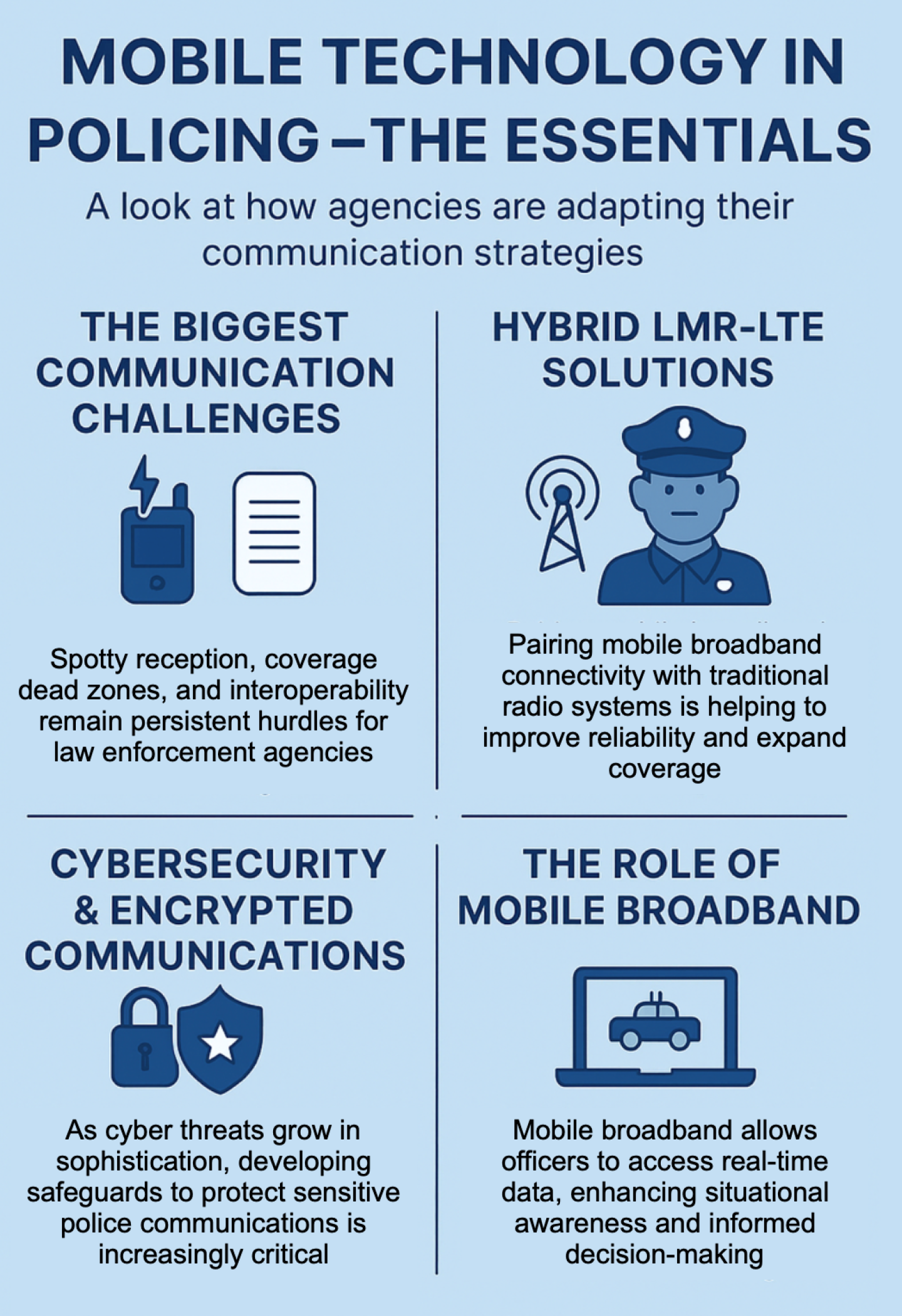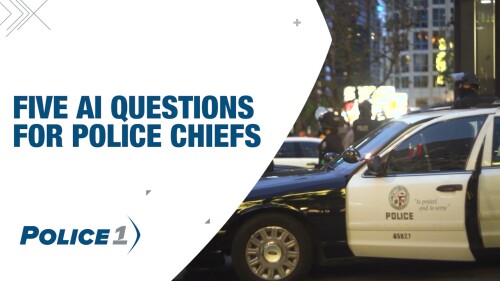Next-generation law enforcement communications are advancing faster than many departments are equipped to handle. The conversation is no longer just about radios or cell coverage— it’s about 5G, cloud-based platforms, cyber-resilience, and integrating emerging technologies like AI and drones into the daily workflows of patrol officers. But while some departments are piloting next-gen solutions, others are still trying to close basic infrastructure gaps.
In this evolving landscape, public safety leaders are being asked to do more with less, plan farther ahead, and build communications systems that are secure, scalable, and future-ready. For many, that means navigating a hybrid present while preparing for a much more connected—and complex — future.
Key discussion points
- Modernizing infrastructure: How to transition from legacy radio systems to secure, hybrid LMR-LTE solutions that support real-time data, video and voice.
- Building a cybersecurity culture: Why every connected device increases risk — and how training, zero-trust models and continuous monitoring must become standard.
- Operationalizing new tools: How AI, drones and cloud platforms can improve officer safety and decision-making — if properly integrated into daily workflows.
The current landscape: Hybrid communications as the new normal
For decades, land mobile radio (LMR) has been the cornerstone of public safety communications. These systems are prized for their durability, wide-area coverage and ability to operate during natural disasters or network outages. But as the operational demands on officers have evolved — requiring more real-time data, video and interagency coordination — traditional radio alone no longer meets the moment.
To bridge this gap, many agencies are turning to hybrid communications systems that integrate LMR with LTE networks. These systems allow for seamless handoff between radio and broadband connections, enabling officers to maintain voice and data connectivity even in remote or variable coverage zones. This approach gives agencies the reliability of LMR with the flexibility and data capacity of LTE.
For example, a deputy responding to a call in a mountainous or rural region may start with LMR for initial voice communication, then shift to LTE to access building layouts, suspect photos, or livestreams from a drone. Officers can transmit video from a body-worn camera to command staff in real time while retaining the ability to call for backup over a secure radio channel.
Hybrid systems like these are practical, affordable stepping stones — but they’re not the end game.
What 5G can bring to the table
Next-generation 5G networks promise a quantum leap in data speed, latency reduction, and device connectivity. For policing, this is not just a bandwidth upgrade — it’s a platform shift.
With 5G, bodycam video can be streamed live to command centers without delay. Drone footage captured during a search-and-rescue operation can be analyzed in real time using cloud-based AI. Tactical teams can receive instant updates on suspect locations, floorplans, or threat levels — all without buffering or downtime.
The real breakthrough lies in latency reduction. With response times measured in milliseconds, 5G enables truly time-sensitive applications: precision location tracking, biometric recognition on the fly, or real-time augmented reality (AR) overlays during tactical operations. And because 5G can support thousands of connected devices within a small geographic area, it’s well-suited to large-scale events or emergencies where every responder needs continuous access to voice, video, and data. However, this level of connectivity requires more than infrastructure upgrades, it demands robust cybersecurity and intentional planning.
The cybersecurity imperative
With expanded connectivity comes expanded risk. As public safety networks shift to cloud-based and mobile-first systems, they become prime targets for threats and cyberattacks that grow more sophisticated each day.
One type of cyber threat is a ransomware attack. Ransomware is malicious software that locks users out of their systems or encrypts critical files — effectively holding data hostage until a ransom is paid, often in untraceable cryptocurrency. In law enforcement, these attacks can disrupt CAD systems, cripple emergency response, disable dispatch centers and block access to sensitive case files, bodycam footage, or criminal databases.
Some attacks have targeted entire city governments, forcing departments to revert to paper-based systems or pay steep ransoms to regain access. And, because these attacks often exploit weak passwords, outdated software, or unsecured mobile devices, departments with limited IT resources are especially vulnerable.
The attack surface is broad. Every smartphone, mobile router, bodycam, and connected patrol vehicle becomes a potential entry point. Agencies using bring-your-own-device (BYOD) policies or unsecured apps risk compromising sensitive data — including live officer locations, criminal intelligence, and victim information.
To defend against these threats, departments are investing in:
- Zero-trust architectures, which verify every connection and device before granting access
- End-to-end encryption, especially for mobile and video data streams
- Multi-factor authentication for all remote access to sensitive systems
- 24/7 threat monitoring via managed cybersecurity services
- Regular penetration testing and patch management
Tools are only part of the solution. Cybersecurity must become part of agency culture. Officers and staff should be trained not just on how to use devices, but how to identify phishing attempts, create strong passwords, and report suspicious activity. As agencies adopt more mobile and cloud-based tools, their weakest link will always be human error.
The role of AI and cloud command platforms
While 5G and secure networks provide the infrastructure, AI and cloud platforms are rapidly changing what that infrastructure can do. Cloud-based records and dispatch systems give officers real-time access to data from anywhere in the field, eliminating silos and streamlining case management. AI-enhanced analytics can flag anomalies in communications, detect patterns across jurisdictions, or prioritize cases based on urgency and threat level.
For example, a cloud-based command platform might use AI to surface related calls from nearby jurisdictions — linking a recent burglary to similar cases based on modus operandi, suspect vehicle, or time of day. Commanders can see this in a dashboard and allocate resources accordingly, all without needing an analyst to manually compile reports.
These tools not only improve operational efficiency, they also improve safety. Real-time alerts about dangerous suspects, high-risk addresses, or flagged weapons can be sent directly to mobile devices or vehicle MDTs before officers arrive on scene. In fast-moving events like active shooter incidents, these insights can save lives.
Preparing for the decade ahead: What agencies can do now
Future-proofing communications isn’t just about chasing the next big thing, it’s about building a secure, flexible ecosystem that can evolve with the agency’s needs. For departments just beginning to modernize, here are some practical steps:
- Audit your current infrastructure: Understand what’s in place, what’s outdated, and where gaps exist — especially in interoperability and network redundancy.
- Invest in hybrid LMR-LTE solutions: These systems provide an immediate boost in reliability and functionality, especially in areas with spotty coverage.
- Plan for 5G gradually: Engage with vendors, state agencies and service providers to understand timelines and build a realistic rollout strategy.
- Prioritize cybersecurity from the outset: Build security into every new system or device — don’t retrofit it later.
- Train for digital resilience: Ensure personnel are not only trained on new tools, but also to understand their vulnerabilities.
- Push for interoperability: Work with neighboring jurisdictions and mutual aid partners to ensure future systems can talk to each other across agencies and disciplines.
For smaller or rural departments with limited budgets, scalability is key. Many cloud-based platforms now offer modular pricing, allowing agencies to pay for what they need now while retaining the option to expand later. As more departments adopt similar systems, costs are trending downward — putting formerly out-of-reach technology within reach.
The future is connected — and strategic
Mobile policing is no longer just radios and in-car laptops. It’s about building a connected ecosystem that integrates voice, video, data, AI and cloud-based tools into a seamless operational environment. It’s about giving every officer — not just command staff — real-time access to the intelligence, resources and situational awareness they need to make better, faster, safer decisions.
But this future won’t arrive in a single wave. Departments will need to make incremental upgrades, rethink workflows and commit to ongoing training. And perhaps most importantly, they will need to ensure that new tools enhance — not replace — the judgment, discretion and community connection that remain at the heart of policing.
Agencies that start now — with a deliberate, security-first approach — will be best positioned not only to keep pace with technology, but to lead in using it responsibly, effectively, and in service of the public good. Because in the next decade of law enforcement, communication won’t just support the mission. It will shape it.
Continue the discussion
To guide strategic conversations and prioritize investments, police leaders should start with these five essential questions after reviewing the future of mobile policing:
- Are our current communications systems secure, interoperable and ready for future upgrades like 5G and AI?
- What is our agency’s biggest cybersecurity vulnerability — and how are we addressing it?
- How are we training officers to effectively use — and protect — the new technologies we deploy?
- Do our current tools give frontline officers real-time access to the information they need?
- Are we working with neighboring agencies to ensure systems can share data and communicate during mutual aid events?













